Sony Alpha 700 packshot gallery
PRODUCT shots of the Sony Alpha 700 have been released, and are shown here to our standard web page size of 600 pixels or smaller.
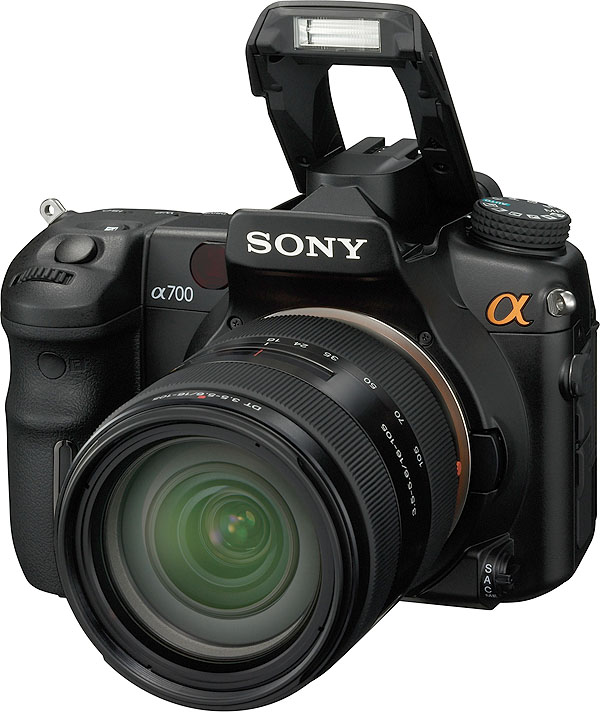
The Alpha 700 has a pop-up flash with GN 12 power. It can act as a wireless controller, and like the 7D, can be set to fire at manual fractional powers (1/1 down to 1/16th). Flash exposure compensation is improved to ±3 stops instead of 2, but is now accessed through the Function Button and menu screens. The lens shown fitted is the new Sony (not Zeiss as rumoured) SAL 16-105mm ƒ3.5-5.6 DT zoom, which is expected to sell for 600 Euros (£399 UK) but will not be available until November.
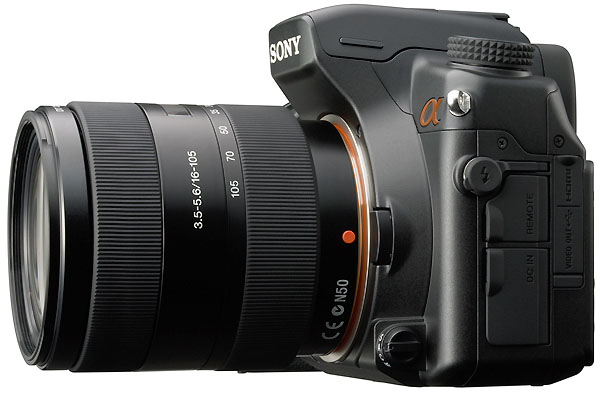
Here’s a side view proving that the rumoured Carl Zeiss blue label is NOT present on this Sony SAL lens.
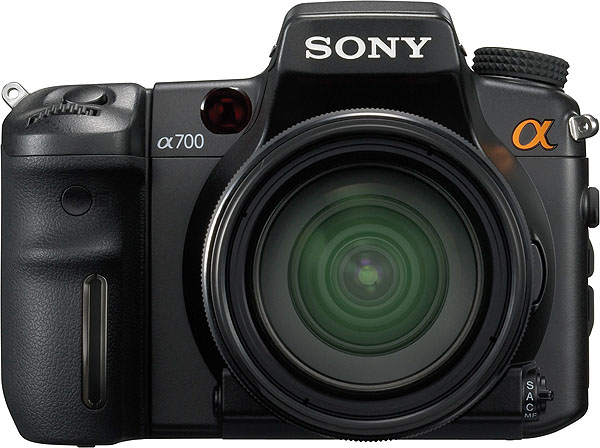
The front view of the Alpha 700 shows the rather odd repetition of the Alpha symbol and the camera model number. The S-A-C-MF switch is almost identical to the control on the 7D. The red window above the Alpha name is AF assist, but may also act as a selftimer warning light and/or the receiver window for the infra-red remote controller. This unit is an HDMI playback commander, rather like a remote for an mp3 player, as well as a trigger for the camera.
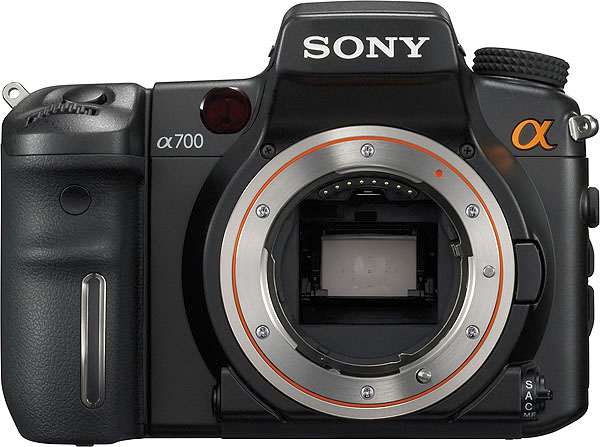
This bit is very important. You are looking at something here which has never been seen before. I’ve just edited this paragraph a couple of hours after writing it to update exactly what you are seeing.
Removing the 16-105mm lens, we find that the lens mount itself has been widened in annular diameter. The orange ring defines the old lens mount size, and the extra metal beyond this is new – and it is NOT part of the mount. It is an exposed circle, machined and polished and fitted with an orange sealing gasket, of the front magnesium alloy camera shell. This ring is part of the exoskeleton of the camera (the black outer covering just skins the mag alloy lightly). It is supporting the entire Alpha lens mount externally, and although no current lenses bear on this surface, it could in theory make a rock-solid mounting for the sort of heavy lenses you just won’t risk hanging off your Alpha 100.
This outer ring will allow larger lenses to have a firmer seating bearing directly on the body you hold, and we can expect to see some designs which makes use of it in future. The ring may also prevent dust and moisture penetrating, though Sony make it very clear this camera is not splashproof or waterproof, it just has generally improved sealing. The depth of field button is identically placed to the 7D. The aperture setting ring uses the modified component design from the 5D/A100 and is very different from the 7D mechanism. The grip sensor modifies Eye Start behaviour to prevent focus being activated when the camera is not held in the hand.
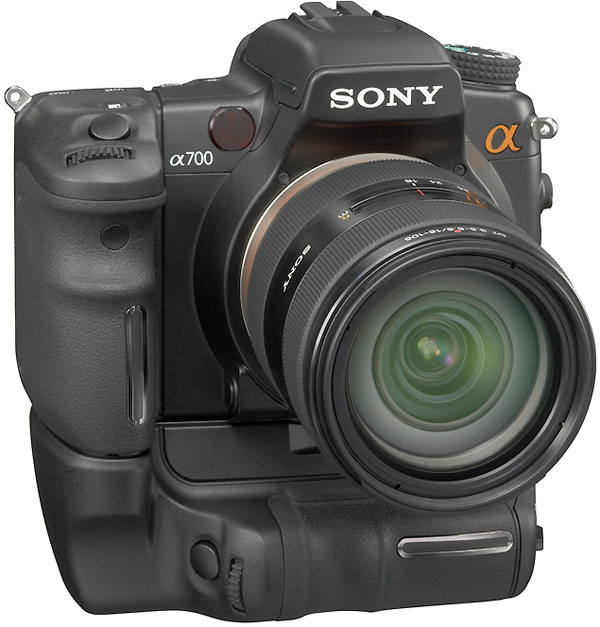
This view shows the flash shoe cover removed, the Portrait Grip fitted, and the 16-105mm from a slightly different angle. This shot is from the UK press archive which is very poor in quality, offering files too small to be used for magazine reproduction unlike the US press center which has very large high res images (but not this shot). Co-ordination of international publicity resources is not apparently Sony’s strong point (as everyone found out who visited their websites yesterday and found partial, ephemeral, vanishing presentations about the Alpha 700 on-line before their due time).
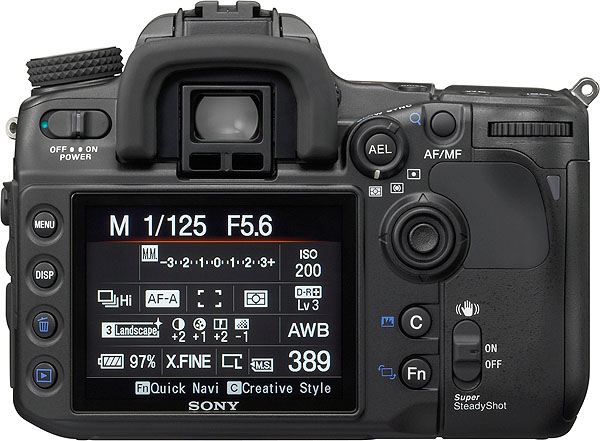
The purpose of the C button when in menu viewing mode is revealed by this rear screen shot – Creative Style settings. These include further colour mode implementations, along the lines of Night and Sunset. One of these is Autumn Leaves. I’m hoping for ‘Scottish Summer’ as well, just press the button and we actually get one… the idea appears to be that you can modify your Scene modes and other settings, and there are three custom memories. How this will compare with the 7D’s excellent hard-wired M1, M2, M3 dial settings remains to be checked out.
The battery indicator has four levels, but in Infolithium fashion it displays a percentage charge remaining figure. The small ‘MS’ symbol is the setting where you choose between the card slot.
The DRO symbol indicates that DRO or DRO+ can be activated, and here it is shown with an adjustment maximum of three Light Values (LV). This means that DRO+ will be limited to making adjustments to bright and dark zones of the image within a three LV compass. This indicates a very good dynamic range, as the adjustments can be applied to the RAW file.
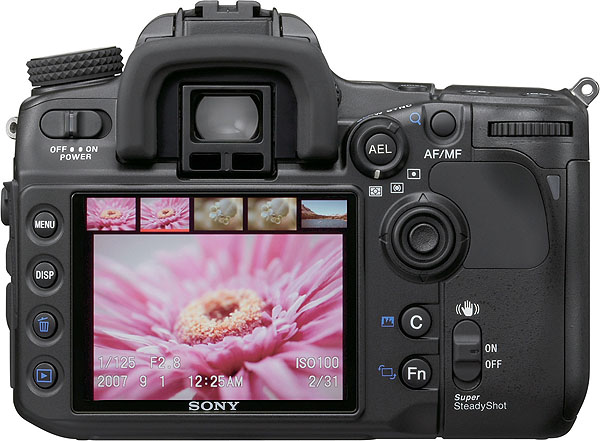
It’s a pity the marketing people did not think to do a shot showing the new RGB histogram function. This is one of the key features expected by professionals who need to know whether any channel clipping is happening. I have not been able to tell, from the few pre-production sample images now currently up on various webpages, whether the colour quality of the A700 is similar to the 7D. Sony has elected to show bright, pastel, subtle images generally which don’t reveal any of the issues that can hit saturated hues.
There is no card cover latch or lock – this is a feature I really dislike on many cameras, including Nikon. It slows down operation and seems redundant; often the most difficult part of changing a card is to operate the lock. There is however a card cover open function to prevent data loss. Much will depend on how this works. Canon’s original version had the effect of wiping out the file being written and flushing anything in the buffer – open the card door too soon, you lost your shot. This was not popular even if it prevented people from corrupting an entire card by pulling the card out mid-write. If Sony’s solution is better than the Nikon locking door and the Canon write-abort-flush (now abandoned for obvious reasons) it will be OK. It would be much more useful to have an audible beep kick in if the card door is opened during writing. That would make you shut it pretty fast.
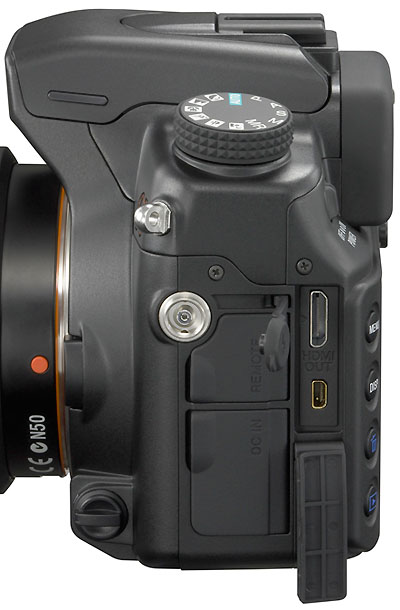
I have brightened up this shot far too much, so that you can see the full detail of the labelling and the connectors. It need 1.48 gamma adjustment in Photoshop Levels. The packshot was so dark the only clear part of it was the threaded flash socket, which resembles the 7D. I do use studio flash, but I’ve never actually found a threaded connector with the correct connections on the other end, and Minolta never sold one. The DC in socket almost certainly uses Sony’s proprietary DC adaptor, which is a pretty negative point. Emergency supplies can not be bought, none of my portable power packs will fit (they work fine on the 7D, whether Quantum or PowerRunner or whatever) and any accessories made to feed DC power into the body need to have a special plug. On the other hand you can’t fry the camera by fitting the wrong source. I have never heard of this happening in the three years since the Dynax 7D appeared.
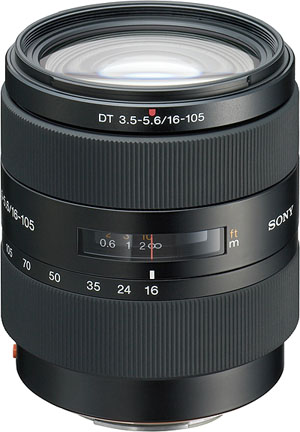
This is the SAL 16-105mm Æ’3.5-5.6 DT zoom. This lens has 50 per cent faster focus gearing than the CZ 16-80mm,if the scary short throw to the manual focus is an indicator. I believe it will be fastest focusing lens in the entire Alpha range. Normally this is accompanied by accuracy issues; the CZ 16-80mm for example needs under 3 revolutions of the camera body drive coupler to cover its entire focus range, while the Tamron 18-250mm requires a full 21 revolutions. Of course the almost useless manual focusing scale could hide a much lower geared mechanism, but Sony has already made optimistic statements about AF speed with the Alpha 700. This lens is probably part of the equation.
Do not think too deeply about retrofitting it to your 7D, 5D or A100 and expecting ultimate focus accuracy at 16mm. My guess is that it will be much like other very short focal lengths and miss the mark often, with such a short focus throw. This optic can not use the wider pitch Æ’2.8 sensor fitted to the Alpha 700. That’s a pity, as this sensor would be extremely valuable for ensuring better accuracy with extreme wides. Owners of Tamron and Sigma 14mm Æ’2.8 lenses, and the KM 17-35mm Æ’2.8-4 D or M/KM/Sony 20mm Æ’2.8 and 16mm Æ’2.8 can feel a bit happier. Their lenses will permit use of the extra-accurate AF sensor.
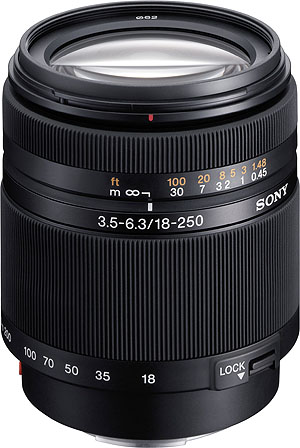
This is the new SAL 18-250mm Æ’3.5-6.3 DT zoom, which is recognisable as the Tamron in drag. We have been using the Tamron now for some time, and it’s an exceptional bit of glass. The Sony should be equal or better. Sony has kept the Tamron zoom lock, which latches the lens at 28mm setting (no other) to prevent it tromboning out and weakening the zoom barrels during walkabout shoots. Maybe the Sony lock can fix the zoom at any focal length, not just 18mm. That would be an upgrade relative to the Tamron.
Now study that focus scale. See the distances between 2 metres and infinity – loads of precision adjustment at long distances. The 18-250mm Tamron is the same. I’ve just been our shooting stuff yesterday, and on a distant view right into the sun with the Tamron, it locked focus precisely between the tree and the castle – just where I aimed, on the fields, for this shot:
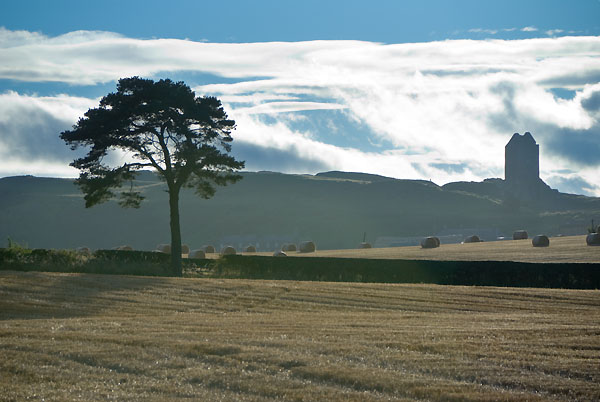
The sun is bright, clear and literally just above the castle out of frame, with my hand shielding it and touching the lens hood. The focus is on the round bales, and at Æ’8 and 200mm, the depth of field is such that the tower and the tree are both just out of perfect focus. If you want extremely accurate focusing, the SAL 18-250mm will be your friend. Let’s hope it proves a little faster than the Tamron version without losing the accuracy.
Neither of these two lenses matches any of the new designs previewed at PMA and shown on our page which covers these prototypes or models. The 16-105mm is not one of the types previewed, and Sony has developed it without revealing its arrival for obvious reasons. There is no lens remotely close to it from any other maker, and it will be a big selling point.
Further images will follow in my next post, along with the full text of the Sony UK press release covering the camera.
– David Kilpatrick
http://photoclubalpha.com/2007/09/06/sony-alpha-700-full-specification-sheet/
